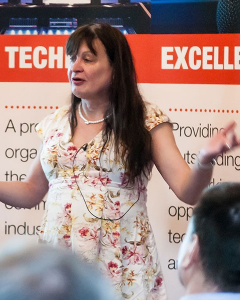Sampled data processing is now a fundamental part of all aspects of electronics. As well as the obvious fields of audio, video, and communications, it is also used in robotics,
AI/ML, control, and energy systems. All these systems rely on the processing of digital samples in some way.
Shannon-Nyquist sampling is so pervasive that we can forget that, like any theory, there are terms and conditions attached. In particular, it assumes that a signal is processed in a linear fashion and that there are no time-varying operations. One example of where this can break down is in the simple act of measuring a waveform’s level.
Measuring level is an important part of many audio devices. Meters, limiters, compressors, etc. all require accurate, and often instantaneous, measures of a waveform’s value. However, because the audio waveform is sampled, the actual level may not be a sample value, but instead may be an intermediate value between samples which may be higher, or lower, than the adjacent samples. Various methods have been proposed to ameliorate this.
This talk, which will be accessible to a wide variety of backgrounds, will discuss the issue of deriving the true signal value from the sampled audio. Sometimes it is necessary to reconstruct the analogue waveform to have accurate results. The pros and cons of various methods of measuring the peak value will be discussed, including a simple approach that provides accuracy with low computation and delay. Finally, we will conclude with a discussion of why knowledge of the intermediate sample values is required for other non-linear operations, and some methods of achieving this.
By the end of the talk, we will realise that, “The Samples Truly Are Not What They Seem!”

Jamie Angus-Whiteoak is Emeritus Professor of Audio Technology at Salford University. Her career in industry and academia has spanned integrated optics, acoustics, analogue and digital signal processing, and her expertise ranges from valve (tube) circuits to the applications of esoteric number theory in signal processing. Jamie has invented modulated, wideband, and absorbing diffusers, direct processing of Super Audio CD signals, and one of the first 4-channel digital tape recorders. She worked in signal processing, analogue circuit design, and numerous other audio technology topics, and has been active throughout the AES for 30 years. Aside from pioneering degree-level courses in both music technology and electronic engineering in the UK, Jamie has been awarded an AES fellowship, the IoA Peter Barnett Memorial Award, and the AES Silver Medal Award for her contributions to audio and acoustics. She is also an honorary fellow of the ISCVE and is currently AES VP for Northern Europe.
We are grateful to the School of Electronic and Electrical Engineering at the University of Leeds for their kind agreement to host this hybrid event, which is jointly presented by the Audio Engineering Society (AES) and the Institute of Acoustics (IoA).
The lecture will be held at the University’s premises on Woodhouse Lane, Leeds LS2 9JT (directly opposite The Eldon public house). Tea and coffee will be available in the foyer from 6.00pm.
Registration for the online stream of this hybrid meeting is available via the Zoom link here.